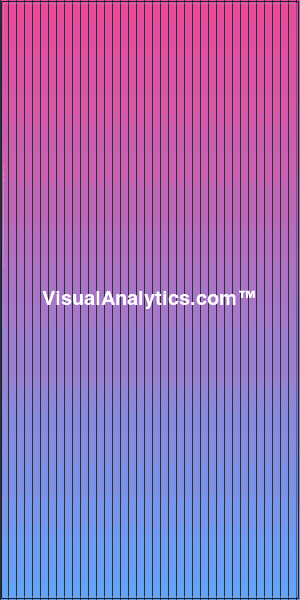
Published · Financial & Blockchain Analytics · 16 minute read
Applying Visual Analytics to Financial and Blockchain Networks
Financial institutions and blockchain innovators share a common challenge: understanding flows across distributed networks. Visual analytics—grounded in centuries of ledger visualization and modern design—reveals patterns hidden within transaction data, treasury allocations, and smart contract relationships. This article charts the historical roots of financial visualization and outlines how VisualAnalytics.comtm delivers static dashboards that drive confident decisions.
Long before cryptocurrencies, merchants tracked trade routes and currency exchanges with illustrated ledgers. Seventeenth-century Dutch booksellers used double-entry bookkeeping diagrams to compare inflows and outflows. Nineteenth-century economist William Stanley Jevons experimented with “money charts” to visualize price indices. These historic artifacts prove that finance professionals have always relied on visual cues to comprehend complex movements.
Today, decentralized finance (DeFi) platforms, banks, and fintech startups handle one unifying question: where does value travel? Visual analytics provides a composable answer. By combining network diagrams, chord charts, flow maps, and annotated timelines, we show risk officers, compliance leaders, and strategists how capital shifts across time and counterparties.
From Ledgers to Blockchains: A Brief History
Understanding the evolution of record keeping reveals why visual analytics is essential:
- Double-Entry Ledgers (1400s): Luca Pacioli’s treatise standardized accounting, encouraging symmetrical representations of debits and credits—a precursor to modern flow diagrams.
- Stock Ticker Tape (1860s): Thomas Edison’s ticker machine printed real-time price updates, making data visualization a requirement for traders monitoring markets.
- Portfolio Theory Graphs (1950s): Harry Markowitz popularized efficient frontier plots, demonstrating how scatter diagrams inform risk-return trade-offs.
- Blockchain Transparency (2009+): Public ledgers like Bitcoin introduced address-based transaction graphs accessible to anyone with the right analytical tools.
Each milestone underscores a consistent theme: visualization transforms linear records into strategic intelligence.

Key Visual Building Blocks
VisualAnalytics.comtm uses a toolkit tailored for financial and blockchain data:
- Chord Diagrams: Ideal for visualizing currency flows between business units or wallets. ribbons quantify volumetric relationships while direction arrows highlight net senders/receivers.
- Ledger Heatmaps: Grids display balances across dates or counterparty categories, revealing anomalies. Inspired by hand-colored ledgers, we use gradients that maintain accessibility.
- Network Graphs: Force-directed layouts show token swaps, liquidity pool interactions, or correspondent banking pathways.
- Timeline Ribbons: Annotated charts align market events, regulatory announcements, and internal actions, aiding compliance narratives.
Each visualization is paired with descriptive text, footnotes, and risk considerations. Accuracy is non-negotiable; we validate sources, confirm balances, and document assumptions within accompanying metadata tables.
Case Study: Mapping a Treasury Desk’s Liquidity
A multinational treasury team struggled to reconcile daily cash positioning across dozens of accounts. Traditional spreadsheets listed balances but failed to communicate structural dependencies. We created a static liquidity atlas combining chord diagrams (for inter-company transfers), heatmaps (for currency exposure), and timeline annotations documenting hedging actions. A 300×600 half-page ad promoted internal training on liquidity best practices, aligning with the dashboard’s call to action.
Within weeks, the treasury desk identified idle balances exceeding policy limits and reallocated funds, reducing borrowing costs by 11%. The static dashboard became a staple of weekly executive reviews because it summarized complexity without requiring live logins.

Blockchain Forensics with Precision
Blockchain analytics introduces unique visualization challenges: pseudonymous addresses, rapid transaction velocity, and branching smart contract calls. We adopt Gephi-inspired layouts, layering node importance (degree, betweenness) with transaction volume. gradients differentiate legitimate exchanges from high-risk mixers. Pin-stripe borders reference early webmaster aesthetics while signaling caution sections.
Static dashboards work well for compliance teams that must document investigations. Each page includes:
- A hero narrative summarizing suspected behaviors.
- A network diagram showing address clusters and bridging nodes.
- A timeline of transaction bursts aligned with known hacks or announcements.
- Callout cards referencing blockchain explorers, legal notices, or on-chain governance votes.
Because the dashboards are static, they can be attached to case files, emailed securely, or archived for audit trails without exposing live endpoints.
Risk Management and Accessibility
Financial audiences demand precision. We ensure each visualization includes scale legends, rounding notes, and scenario commentary. Accessibility remains vital: contrast ratios, keyboard navigation, and descriptive alt text help compliance officers with assistive technology needs. Static delivery also reduces security risks associated with remotely hosted dashboards.
For blockchain-specific contexts, we include disclaimers about potential false positives, network latency, and evolving smart contract states. Transparency about limitations honors the ethical foundations set by early statisticians.

Implementation Roadmap
Organizations can adopt visual analytics in four phases:
- Data Discovery: Inventory ledgers, custody systems, blockchain nodes, and third-party datasets. Document refresh cadences and data owners.
- Modeling & Segmentation: Classify transactions by purpose (operational, hedging, compliance). For blockchains, label addresses via on-chain heuristics and vendor intelligence.
- Visualization & Narration: Craft utility-first layouts featuring hero sections, ad placements, and annotated charts. Record methodology in sidebars.
- Operationalization: Package deliverables into `public.zip`, schedule review cadences, and integrate with Plausible analytics for usage monitoring.
Continuous improvement comes from stakeholder feedback. We encourage teams to log questions raised during reviews; these prompts guide future iterations.
Conclusion: Illuminating Financial Systems with Confidence
Financial and blockchain ecosystems thrive on trust. Visual analytics builds that trust by transforming raw transactions into transparent stories. VisualAnalytics.comtm channels historical ledger craftsmanship, aesthetics, and static deployment discipline to help organizations spot risk, seize opportunity, and communicate clearly with regulators and partners. In a world where value flows faster than ever, a well-lit map is the most valuable asset you can own.